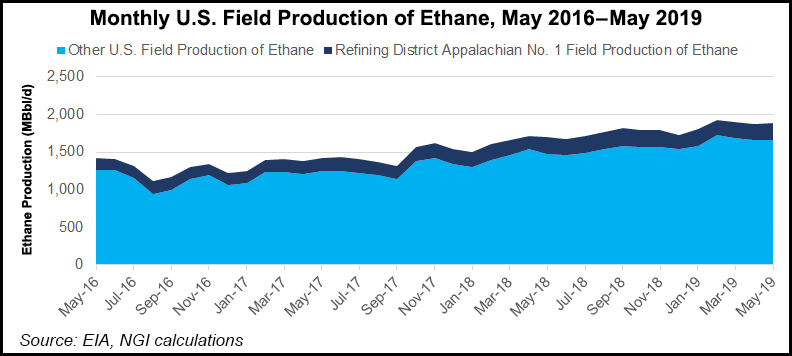Infrastructure | NGI All News Access | NGI The Weekly Gas Market Report
West Virginia Task Force to Promote Appalachia’s Emerging Petrochemical Industry
West Virginia Gov. Jim Justice has signed an executive order establishing a task force dedicated to creating more downstream manufacturing opportunities as the region’s petrochemical industry expands.

Officials from several executive branch agencies, along with other business and energy leaders, are to make up the task force.
“The potential is endless. This is one of the most important moments of our time,” Justice said recently during a West Virginia Chamber of Commerce event, where he announced the formation of the task force. “In order to reach that potential, we need to have downstream manufacturing operations already in place. And that’s where this new task force comes in.”
Justice, a Republican, has named state Department of Environmental Protection Secretary Austin Caperton to lead the committee. Revenue Secretary Dave Hardy, Commerce Secretary Ed Gaunch and tourism Commissioner Chelsea Ruby have also been picked from the administration to work on the task force.
“This is, quite frankly, the best economic opportunity we’ve had in this state in a very long time, and it is important that we take every step possible to maximize the opportunity,” Hardy said.
Justice’s executive order comes a few weeks after Braskem SA indicated that it would cancel plans for a multi-billion dollar ethane cracker in the state. The company confirmed that it has hired a financial adviser to evaluate strategic alternatives for its site in Wood County, including a possible sale. But the petrochemical industry is expanding in the region.
Royal Dutch Shell plc is building a multi-billion dollar ethane cracker in western Pennsylvania, while Thailand’s PTT Global Chemical pcl is rumored to be close to moving forward with a similarly sized facility in southeast Ohio.
The task force is the latest in a series of private and public sector efforts to further study and promote the region’s petrochemical advantages, including companies that could use more of the raw materials that could be produced by the crackers.
The Gulf Coast is unequivocally North America’s petrochemical stronghold, but the federal government views the Appalachian region as ripe for an expansion to bolster the nation’s production capacity and supplies, especially given robust unconventional natural gas production from the Marcellus and Utica shales.
The Department of Energy released a study last year to show the feasibility of building out a natural gas liquids hub in the region, noting that one-third of domestic petrochemical activity occurs within 300 miles of Pittsburgh. Shell has said that although the bulk of refining capacity is on the Gulf Coast, 70% of the nation’s polyethylene consumers are within 700 miles of the Mid-Ohio Valley, a region that includes parts of Ohio, Pennsylvania and West Virginia.
The Justice administration plans to build on that expectation, indicating the task force will focus on encouraging other energy operations to locate at various points throughout West Virginia to support the construction of additional petrochemical facilities.
Other members of the task force include Javier Reyes, dean of West Virginia University’s college of business and economics, and James Wood, interim director of the university’s Energy Institute.
© 2024 Natural Gas Intelligence. All rights reserved.
ISSN © 1532-1231 | ISSN © 2577-9877 | ISSN © 1532-1266 |
